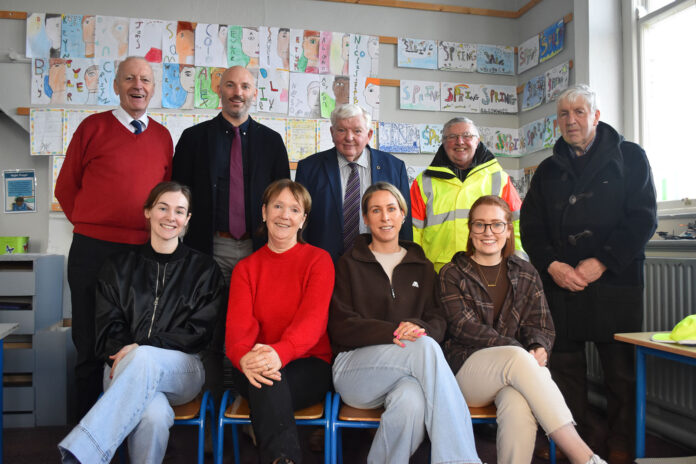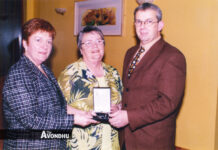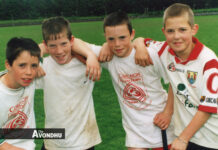
The monument of Dr Timmy Murphy, Bishop of Cloyne from 1849 to 1856 continues to stand proud on MacCurtain Street in Fermoy, overlooking the town from where boys of Fermoy are educated at his namesake school.
Led today by Principal Joe Aherne, the school is a thriving hub of modern education, taking a pupil-centred approach to their innovative and forward-thinking curriculum.
With a long tradition of education, times have certainly changed at Bishop Murphy Memorial School, however, the ethos and values of the school have carried through to today.
A sure sign of this continuing ethos can be seen in the uniform and school crest, where the mitre (bishop’s hat), along with the five steps symbolising the classes taught at the school – second, third, fourth, fifth and sixth – are evident.
Tom Murray, chairperson of the board of management and former pupil of the school, explained that in their day, there were no uniforms and Bishop Murphy Memorial School looked very different, teaching both primary and secondary pupils.
Attending the school from 1958 to 1964, Mr Murray explained that the back yard of the school where the children played was once in ‘terrible condition’.
“People were constantly falling, the ground was so rough. You were constantly cutting your knees. All the primary was wearing short pants, and you’d be taken out up to the Blue Nuns to be patched up. This was a daily occurrence, there would always be someone (injured),” he recalled.
A large monument stood in the yard at the time, while the surface of the yard was full of stones and tree roots, however, in 1961, ahead of the 1963 centenary year, the monument was demolished and the yard levelled.
CHILD-CENTERED APPROACH
Education at the time had a very different approach, as Mr Murray noted that the classroom consisted of a blackboard, chalk and a duster, with the teacher at the top of the room.
Seán Ó Murchú, a past pupil, found his love for Gaeilge at Bishop Murphy Memorial School, however he also explained the difficulty he and his classmates had during mathematics with their teacher’s methods.
“You could spend hours the night before trying to work out the solution but the teacher would go up to the board, write four or five lines and you’d ask ‘how did you do that sir?’. And he would say ‘you’ll find that out’ and be pointing his finger, but he’d never explain it,” he said.
Today at Bishop Murphy Memorial School, principal Joe Aherne explains that the curriculum is child-centered and becoming more advanced each day.
“Traditionally, with maths, you had to learn how to do it and how to get there, whereas now the teacher facilitates the class by encouraging pupils to think and share. They do offer strategies, but the approach is after changing completely.
“There are interactive whiteboards in each room and we purchased two more this year. During Mr O’Donoghue’s time (former principal), we were the first fully equipped iPad school. We still remain an iPad school and we’re trying to maintain that link with technology. Modern children would have good access to iPads in this school but we do try and limit their usage. The penmanship is still very important. The ability to be able to work both digitally and non-digitally has value. We’re trying to futureproof children and make them more resilient,” Mr Aherne explained.
CHANGE FOR THE BETTER
Ger Slattery, another former pupil and well-known local lollipop-man for 16 years, also notes the difference in pupils now, compared to when he was attending school.
“They’re all coming in happy. Kids would be afraid one time, of what to expect if they were late for school, but now they’re laughing and joking. Kids are happy going to school now, there’s no fear in them. It’s a different environment now, as it should be,” he said.
Seán Ó Murchú was among the past pupils who would cycle long distances to get to and from school each day, as he recalled pupils cycling to Bishop Murphy Memorial School from Castletownroche, Watergrasshill and Ballynoe.
“In the mornings, they always had newspapers for the lads to stick up the leg of their trousers so they wouldn’t be soaked through to the skin and be wet all day,” he recalled.
Teachers in years gone by also had their work cut out for them, as former principal Paul Cotter explained that during his 36 year career, of which he was principal for 25 years, he spent all his days teaching the children of Fermoy.
“From a principal’s point of view in the early years, you didn’t have that much responsibility. It was the same as every other classroom teacher. There wasn’t that amount of leadership required. The paperwork and duties built up over the years and it was almost impossible to teach. We had at one stage 230 or 240 pupils and we still had only five teachers,” he recalled.
HELPING PUPILS REALISE THEIR POTENTIAL
Today, the school has an administrative principal who has no classroom duties but deals with the day to day running of the school across a wide spectrum, with a deputy principal supporting the role of the principal, and assistant principals, offering a drip-down model of leadership designed to keep all areas strong and running well within the school, tying into an overall school implementation plan and working towards specified areas of improvement gradually as the school grows and develops.
Currently, Bishop Murphy Memorial School has 13 different nationalities attending the school, two Special Education classes, and offers English as a Foreign Language class to pupils.
Special education is at the heart of the school, with the Rainbow and Solas rooms situated within the centre of the building.
Across the school, there is a keen awareness towards neurodiversity and a culture of respect towards neurodiversity and different abilities, with socialising and interaction across the classes encouraged as the ASD special class model is ultimately to provide integration to mainstream.
Clare Coughlan, who is currently the longest-serving member of staff having taught at the school since 1996, explained: “Kids are very happy going into school now. They love each other’s company and they love working together. There’s great camaraderie. I’m teaching the ASD unit and we did a cake sale for the unit two weeks ago. When the boys came down, they were all buying cakes and sharing money, if someone had no money someone else was buying them a cake. There is a lovely atmosphere.”
She also noted that the methods of education have advanced massively during her time.
“The instruction methods are completely different now. They do a lot of group work and teamwork and pair work. It’s way different with them learning from each other, way more than when I started. You used to be at the top of the class teaching, whereas now there’s definitely more learning from each other and cooperation,” Ms Coughlan said.
Across the staff of the school, there are currently 11 teachers, 9 SNAs and a secretary. Speaking on the Special Education Teachers and SNAs, Mr Aherne said: “They’re very much the oil in the engine at Bishop Murphy Memorial School. They ensure with the teachers that all students have access to the curriculum and realise their full potential”.
TRADITIONAL VALUES – MODERN METHODS
At the time of the school’s centenary, then-principal Paul Cotter stated: “While we are commemorating the one-hundredth birthday of the school we must remember that a school is more than a building. The building is just the focal point of the activities of the school: it is the community that populates it that makes it a school – the pupils, the teaching staff, the ancillary staff, the parents, the board of management, the parents’ association, the local community and the host of occasional visitors that call to the building throughout the school year. These are the people who combine to create and define the ethos of the school”.
Mr Cotter’s words at the time still ring true today, binding the school’s traditional values with its modern teaching methods.









